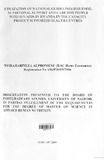Utilization of national guidelines for food, nutritional support and care for people with HIV/Aids in Rwanda in the capacity project supported health centres

View/
Date
2009-02Author
Nyirahabineza, A
Type
ThesisLanguage
enMetadata
Show full item recordAbstract
Rwanda has engaged in the fight against I-F\' AIDS by addressing mainutrition among
people with HIV IAIDS through adoption of the guidelines for food and nutritional
support and care of people with HIV/AIDS since 2005. The objective and purpose of this
study were therefore: a) to evaluate the utilization of the national guidelines for food and
nutritional support and care for people with HIV/AIDS in Rwanda in the Capacity project
supported health centres and b) determine their food and nutrition situations. This was
investigated under six specific objectives, two research questions and three hypotheses as
reflected in the results. The specific objectives were to establish the extent to which the
national guidelines for food and nutritional support and care for people with HIVIAIDS
are being utilized, challenges encountered by health providers and clients in the service
delivery, perceptions of the clients to the services given, their socio-demographic
characteristics, nutritional status. dietary diversity and other food related factors. The
sample consisting of twelve (12) service providers and one ninety two (192) (one sixty
five females (165) and twenty seven (27) males) people with HIV/AIDS was drawn from
those participating in food and nutrition programmes in Capacity project supported health
centres. Selection of Capacity project supported health centres and providers were
purposive while selection of people with HIVIAIDS at the health centres consisted of all
the clients who were present at the time of interview. Data were collected using
structured questionnaires and anthropometric measurements. Data management. entry,
cleaning and analysis were done using the statistical Package for Social Sciences
software (version12.0.1) and analysis of results done by simple descriptive statistics.
bivariate analysis (chi-square), correlation and tests of equality of means.
The results showed that the national guidelines were used to an extent of 27.9%; which
led to the rejection of the hypothesis that ··the utilization of guidelines for food and
nutritional support and care of people with HIVIAIDS in Capacity project health centres
is adequate". It has also answered the research question that was addressing how the
guidelines were being utilized. The clients' satisfaction to the service offered in food and
nutrition programme was rated as 61.1% while the main challenge of both providers and
their clients (90.1 %) is lack of food expressed either as insufficient food aid (62%) and/or
lack of income generating activities "::!);.] I- This also answered th; second research
question that v>'asdeicrm inin~l the chal lenge'c facco ~y both ci iellis and prov: cie:·~·in the
programmes. The age of the respondents ranged between 19 and 74 year with a mean of
35.4 and a median of 35. Their main occupation was farming (93.2%) with a level of
education not exceeding primary education (94.3 %). It was found that the nutritional
status showed that 8.4% were underweight, 83.1% had a healthy weight. and 8.5%
overweight; hence a total of 16.9% that were not of a good nutritional status. The mean
individual dietary diversity score of the respondents was three (3) food groups per
individual. Further analysis showed that gender was the only socio-dernographic
characteristic that was statistically different between both the individual dietary diversity
and nutritional status (p<0.05); this led to the decision to partially reject the second
hypothesis that "there is a positive relationship between the socio-dernographic
characteristics and both the individual dietarv. diversity. and the nutritional status of the
respondents". The third hypothesis that "there is a positive relationship between the
respondents' dietary diversity and nutritional status" was also rej ected as the findings
showed a negative correlation even if it was not significant (r=-0.075 and p=0.325).
The data led to the conclusion that: in Capacity project supported health centres. national
guidelines for food, nutritional support and care of people with HIV /AIDS were
inadequately utilized, people with HIV/AIDS are moderately satisfied with the service
given, they are food insecure and nutritionally at risk of both under and over nutrition and
they have a low mean individual dietary diversity.
It is recommended that the Capacity project ensures that food and nutrition activities are
fully and adequately included in the management package for the control of HIV/AIDS
disease by offering services recommended in the guidelines. initiating productive income
generating activities, offering food aid to those people who are food insecure (based on
fixed entry and exit criteria to avoid dependency) and emphasizing on nutrition education
of the targeted People with HIV/AIDS. The last recommendation but not least is that the
Ministry of Rwanda conducts a national evaluation on utilization of the national
guidelines for food and nutrition for People with HIV/AIDS.
Citation
Degree of Master of Science in Applied Human Nutrition, University of NairobiPublisher
University of Nairobi Department of Home Economics
Description
Dissertation presented to the board of
Postgraduate Studies, University of Nairobi,
in partial fulfillment of the requirements
for the Degree of Master of Science in
Applied Human nutrition
